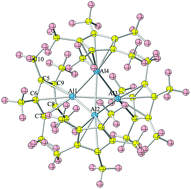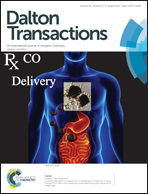Influences of the substituents on the M–M bonding in Cp4Al4 and Cp2M2X2 (M = B, Al, Ga; Cp = C5H5, X = halogen)†
Abstract
Although the geometries of Cp*4Al4 (Cp* = C5Me5) and Cp4Al4 (Cp = C5H5) are similar, Cp*4Al4 is more stable than Cp4Al4. Cp*2Al2I2 is the first complex involving an Al(II)–Al(II) bond to be supported by Cp-type ligands. In this work, the stability of Cp*4Al4 and Cp4Al4 (Cp = C5H5), the nature of M–M bonding in Cp2M2X2 (M = B, Al, and Ga), and the influences of the X atom on the M–M bonds have been analyzed and compared within the framework of the atoms in molecules (AIM) theory, electron localization function (ELF), energy decomposition analysis (EDA), and natural bond orbital (NBO) analysis. The calculated results show that Cp*4Al4 is more stable than Cp4Al4 because of H⋯H interactions between the methyl groups on the same and different Cp rings and not because of the Al–Al bonds. In Cp2M2X2, the B–B bond is stronger than the Al–Al and Ga–Ga bonds. The B–B bond is most consistent with covalent bonding, whereas the Al–Al and Ga–Ga bonds are more consistent with metallic bonding. The strengths of the B–B bond increase in the sequence X = F, Cl, Br, and I, whereas the Al–Al and Ga–Ga bonds decrease in the sequence X = F, Cl, Br, and I. The different change tendencies arise from the different M–M bonds and the orbital interactions between atoms X and M.


 Please wait while we load your content...
Please wait while we load your content...